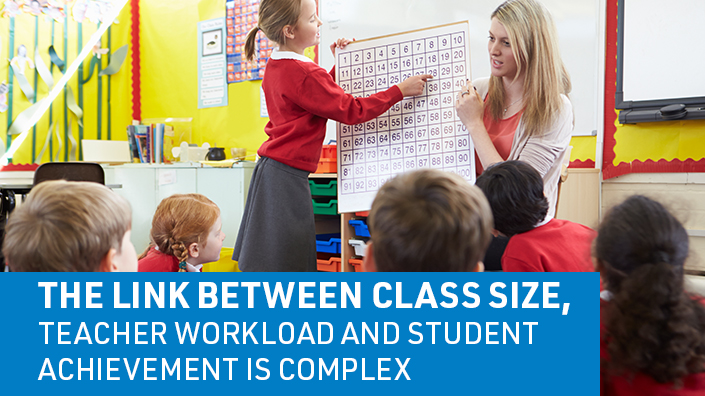The link between class size, teacher workload and student achievement is complex.

Research and argument into the impact of class size and teacher workload on student achievement regularly presents in the media and academic papers, in research and schoolyard discussions. Research suggests that the effects of smaller class sizes “have been hard to isolate and measure,” which has led to disagreements over the results. Understanding the connection between class size and student achievement, as well as teacher retention (and workload), is critical to the success of all students in our education system.
Rather than just focus on ‘class size’ itself, it is vital to consider the component elements that make up every classroom – the students, the teachers, the community and parents, the school, the year level and the curriculum. Arguing which element is more important overshadows the key purposes of students attending school – the learning outcome and their multi-faceted social and educational development.
Professor Diane Whitmore Schanzenbach argues that smaller classes are better for students, particularly in the early grades and for low-income families. eSchool News report that research in Tennessee, USA, conducted over 20 years from starting school with randomly assigned students in small classes, proved that students achieved higher levels throughout their schooling. This applied even through high school where they were more positive about participating in their learning and they were more likely to graduate from high school and go on to higher education and training.
National Chair of the Association of Heads of Independent Schools of Australia Mark Merry said class sizes should be lowered across the country’s younger primary years. “Lowering those class averages for little ones … means greater resources for teachers, but again it’s going to come back to the big issue in education in Australia — and that is teacher recruitment and teacher quality.”
Key benefits of smaller class sizes include: establishing stronger relationships between students and teachers – the teacher has more potential to identify students on the ‘edge’ of the group in their learning – something that may be difficult to observe in larger classes; and, students may collaborate better because there are less students for teachers to potentially discipline and control, giving the teacher more time to grow the collaboration and achieve in-depth learning.
As noted, the argument of class size is not clear-cut. The effectiveness and quality of teaching, the ability of the school administration to harmonise its teaching workforce into a quality school culture, the financial viability of the school and its resources, the socio-economic background of the school and its community, and the school infrastructure all form key elements of the education platform. Even before the teacher starts teaching, these elements have the power to disrupt student learning.
In the The Educator, Save Our Schools national convenor, Trevor Cobbold, argues that: “The increased workload, especially time spent on management and administration, and the stress it places on their lives is a reason reported by many teachers for leaving the profession”. Australian teachers also spend more work hours on lesson planning, collaboration with other teachers and marking student work than in most OECD countries. The Australian average of 15.9 hours is significantly higher than the average for the OECD of 13.5 hours.
Reducing teacher workload on administrative duties enables teachers to teach, to plan their lessons to meet the Australian Curriculum standards and to have more contact time to engage with their students.
Arguing that smaller class size is better for students should be considered from all of the aspects discussed here. They are all interconnected and at any time, each has the potential to derail the education process – regardless of class size.
The IEU strongly supports teachers to continue to push for better workloads through manageable class sizes that yield quality education for all students, and in turn, create a school learning environment and community that parents will want to bring their children to.
That would be a win for all.
Sources and further reading:
https://www.eschoolnews.com/2019/11/12/class-size-matters-understanding-the-link-between-class-size-and-student-achievement/
https://theconversation.com/how-much-of-a-difference-does-the-number-of-kids-in-a-classroom-make-125703
https://www.studyinternational.com/news/school-classes-size-matter/
https://www.theeducatoronline.com/k12/news/teacher-workloads-on-the-rise–report/265040story/f5e673cfc141070d6dad84fead875e0f
https://www.dailytelegraph.com.au/education/schools-hub/smaller-class-sizes-critical-for-learning/news-story/f5e673cfc141070d6dad84fead875e0f

